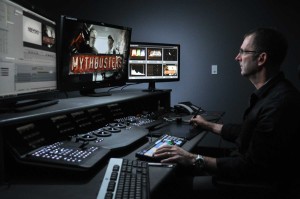 Beyond Productions is using Blackmagic Design‘s DaVinci Resolve Studio to support its postproduction workflow for new virtual reality (VR) content for Discovery Channel’s television show Mythbusters.
Beyond Productions is using Blackmagic Design‘s DaVinci Resolve Studio to support its postproduction workflow for new virtual reality (VR) content for Discovery Channel’s television show Mythbusters.
Beginning with August’s “MythBusters vs. Jaws” episode, Beyond is delivering VR experiences to accompany upcoming episodes throughout the rest of the season, including mail truck explosions, a zombie attack and a rocket launch. The VR content is available via Discovery’s VR smartphone apps for iOS and Android, as well as on a new dedicated Discovery VR website.
“We had been doing our own research into VR and found that Discovery was also doing their own R&D, and they were keen to get content,” said Anthony Toy, director of postproduction at Beyond Productions.
“The first thing we filmed was underwater shark footage,” said Ambar Sidhwani, junior editor and VR editor at MythBusters. “But regardless of where we shoot the footage, we either use a six- or seven-camera rig, shoot static or point of view, 360-by-180-degrees field of view, 4:3 aspect ratio and at 80 fps, which helps us sync the footage later in post.”
Once the footage is brought into post, it’s run through stitching software for syncing, calibration, stabilization and exposure compensation, and as Toy explained, ”It’s like putting a puzzle together of which camera angle goes where to make a canvas. The end result is 4096 x 2048 MP4 file, 4K, 2:1 aspect ratio, 80 fps. High resolution and high frame rate are important for VR, and we found that many post systems couldn’t handle resolution or did weird things to the frame rate.”
“Resolve being resolution-independent was a must as the frame size of the final stitched image does not conform to any conventional formats such as HD, 2K, 4K or UHD,” said Michael Graham, senior online editor at Beyond. “To have the flexibility to work in the native resolution of the stitched image meant no blanking was introduced to the final output, which would affect the way the image wraps around to create the VR 360-degree image.”
“Resolve’s biggest advantage is that it deals with aspect ratio and frame rate natively,” added Sidhwani. “There is no encoding files to other files with different frame rates. Eighty fps is great up to delivery, but the final platforms, such as phones, won’t play 80 fps materials, so the final file is delivered in 30 fps. Resolve does frame-to-frame conversions and makes files longer, so the motions in the footage are smooth at the end of that conversion process.”
According to Sidhwani, this is essential in the virtual world, as people can get sick from sudden jerks. “The smooth motion helps makes the VR experience more immersive and does not make people motion sick, which is key to the experience.”
DaVinci Resolve Studio is also used to grade the footage and grading is done on a computer monitor. “We don’t get video output at that resolution because it’s not a broadcast standard, so we grade on a computer monitor,” Toy said. “The included scopes in Resolve are great and helpful in keeping us within the guidelines.”
The stitching software balances across all the cameras to allow for a smoother stitch and it tries to retain as much detail as possible, sometimes resulting in a flat looking image. However, the Beyond team wants a vibrant, punchy and strong look as the final platforms for the images are VR rigs or smartphone screens.
“The flat image pops up a few hurdles that the tools and power of Resolve help to overcome,” explained Graham. “The original footage is from a compressed 8-bit source so adding saturation and contrast to the image really brings out the compression artifacts and banding. A combination of working in a 32-bit environment in Resolve, the de-noise filter and other elements of the software allow us to push the image a lot further and really work it to achieve the look we are after without having the image looked too processed.”





